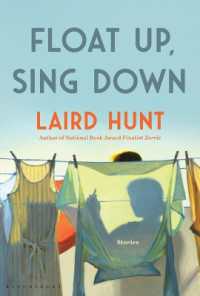- ホーム
- > 洋書
- > 英文書
- > Nature / Ecology
Full Description
Ecostacking is a new concept and approach which aims to maximize the benefits of ecosystem service providers in cropping systems to help achieve the goal of long-term sustainable agriculture and food production. The term "ecostacking" means combining synergistically the beneficial services of functional biodiversity from all levels and types. It is a comprehensive approach, where the various ecosystem service providers are fully integrated with the rest of the cropping system including agronomic practices. It is an approach which goes beyond conventional Integrated Pest Management practises, and attempts to take advantage of all the functional biodiversity of a system. The main focus of ecostacking is on maximizing ecosystem services for biological control and pollination from beneficial arthropods, but the approach also utilizes other invertebrates (e.g., earthworms) as well as beneficial vertebrates such as bats, birds and small mammals. Microbes also provide invaluable ecosystem services including pest, disease, and weed control, either directly as components of "suppressive soils" or as plant colonizers (as endophytes or as epiphytic microbial flora). The ecostacking approach also aims to maximize other nature-provided services such as maintenance of soil health and nutrient cycling. The Concept of Ecostacking is the first book in a series which introduces ecostacking concepts to the reader and explores how this approach can be used in a variety of ways and in different cropping systems. The book defines this new concept and shows, using illustrative case studies from around the world, how ecostacking principles can be successfully employed in cropping systems in the open field, in greenhouses and in forestry. This book: · will serve as inspiration for developing further applications of this breakthrough technology for sustainable agricultural production. · is a must-read for everyone with an interest in developing sustainable crop protection systems and ecosystem management. · has been written and edited by the world's leading experts in this new and exciting endeavour.
Contents
PART I: THEORETICAL PRINCIPLES AND CONCEPTS OF ECOSTACKING IN SUSTAINABLE AGRICULTURE. 1: Theoretical background of ecostacking - origin, needs and development. Heikki MT Hokkanen and Ingeborg Menzler-Hokkanen. PART II: TECHNICAL COMPONENTS AND SUPPORTING TECHNOLOGIES OF ECOSTACKING. 2: Role of microbes in facilitating effective biological control of pests, diseases and weeds. Xiaoyulong Chen, Tomislav Cernava and Gabriele Berg. 3: Priming of plant defences. Ziying Wang, Yixia Wu and Huai Liu. 4: Dual role of the entomopathogenic fungus Beauveria bassiana in insect pest management in the greenhouse. Kaijun Zhang, Xian Wang, Qiu Yang Wei, Huai Liu and Jinjun Wang 5: Potential of plant-plant communication to improve sustainable pest control. Jarmo Holopainen and James Blande. 6: Olfactory manipulation for pest control. Hongbo Jiang. 7: Insect taste. Pål Kvello. 8: Management of agricultural soils to support ecosystem services. Heikki MT Hokkanen and Ingeborg Menzler-Hokkanen. PART III: APPLICATION OF ECOSTACKING IN GREENHOUSE AND OUTDOOR PRODUCTION SYSTEMS 9: Inundative use of entomopathogenic nematodes to curb a forest pest outbreak. Heikki MT Hokkanen and Ingeborg Menzler-Hokkanen. 10: The greenhouse environment: challenges for ecostacking. Guang-Yun Li, Wen-Qiang Chu and Huai Liu. 11: Predatory mites for greenhouse pest management: possibilities for enhanced action via ecostacking. Li Ya-Ying. 12: RNAi promoted ecostacking concept: rebooting biological control for aphid pests. Jinzhi Niu, Huai Liu and Jinjun Wang. 13: Integrating agroecological practices to manage pests while combining organic and conservation agricultures. Fanny Boerave and Severin Hatt. 14: Pesticide use disrupting effective biological control: role of cereal aphids in Finland. Heikki MT Hokkanen and Ingeborg Menzler-Hokkanen. 15: Impact of Integrating Autodissemination with Male Annihilation Technique on fruit fly infestation for enhanced mango productivity in Sub-Saharan Africa. Beatrice Murithi, Gloria Gathura, Levi Ombura and Fathiya Khamis. 16: Ecostacking strategies for avocado production in Florida. Ingeborg Menzler-Hokkanen, Heikki Hokkanen and Daniel Carrillo. PART IV: SOCIO-ECONOMIC IMPACT OF ECOSTACKING 17: Wildflower strips for insects... and people: stacking the social dimension. Severin Hatt. PART V: FUTURE PERSPECTIVES 18: Outlook for ecostacking.







